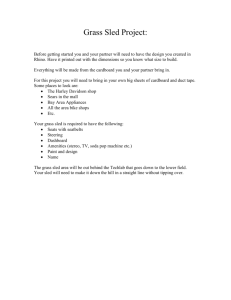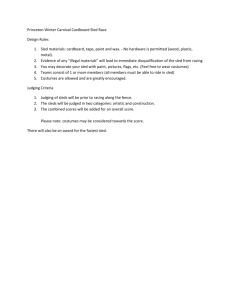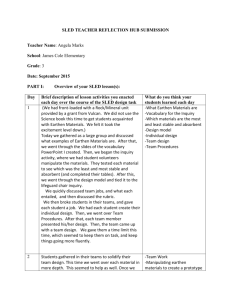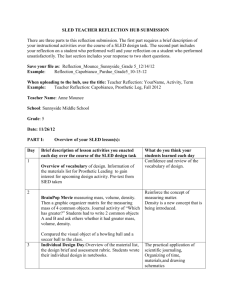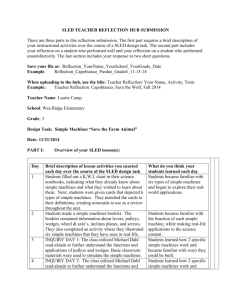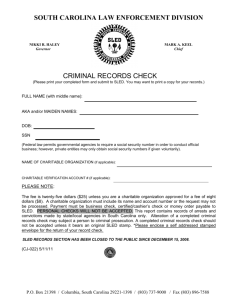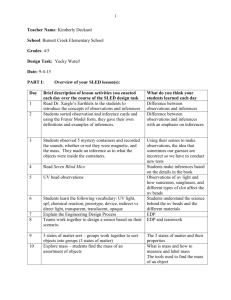Document
advertisement
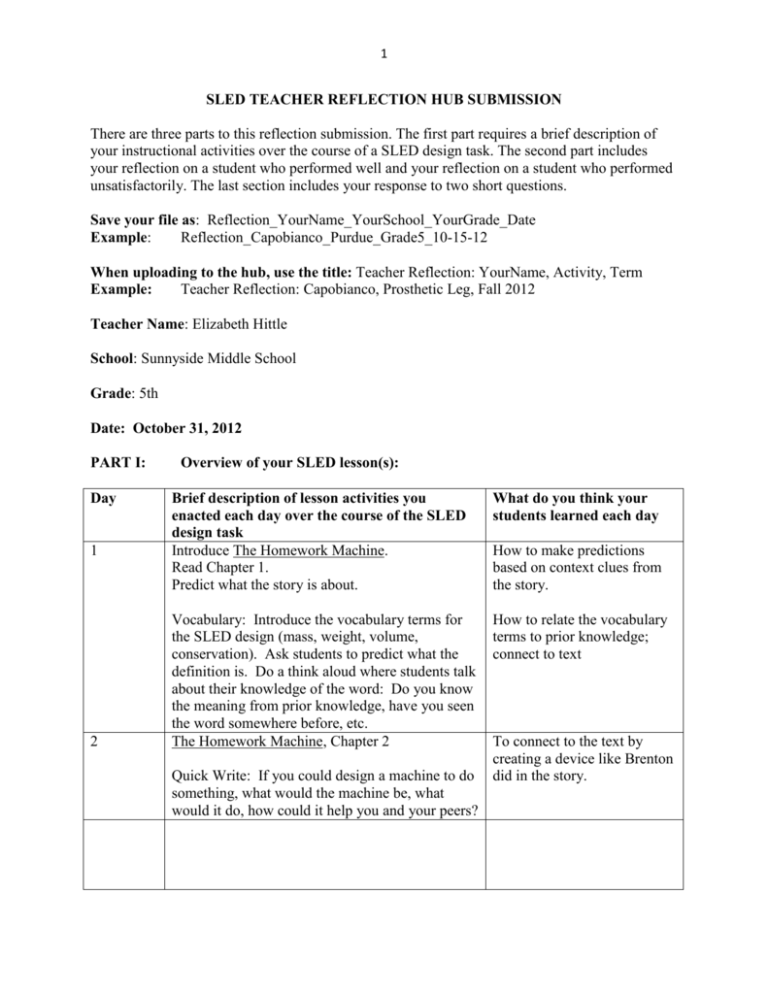
1 SLED TEACHER REFLECTION HUB SUBMISSION There are three parts to this reflection submission. The first part requires a brief description of your instructional activities over the course of a SLED design task. The second part includes your reflection on a student who performed well and your reflection on a student who performed unsatisfactorily. The last section includes your response to two short questions. Save your file as: Reflection_YourName_YourSchool_YourGrade_Date Example: Reflection_Capobianco_Purdue_Grade5_10-15-12 When uploading to the hub, use the title: Teacher Reflection: YourName, Activity, Term Example: Teacher Reflection: Capobianco, Prosthetic Leg, Fall 2012 Teacher Name: Elizabeth Hittle School: Sunnyside Middle School Grade: 5th Date: October 31, 2012 PART I: Day 1 2 Overview of your SLED lesson(s): Brief description of lesson activities you enacted each day over the course of the SLED design task Introduce The Homework Machine. Read Chapter 1. Predict what the story is about. What do you think your students learned each day Vocabulary: Introduce the vocabulary terms for the SLED design (mass, weight, volume, conservation). Ask students to predict what the definition is. Do a think aloud where students talk about their knowledge of the word: Do you know the meaning from prior knowledge, have you seen the word somewhere before, etc. The Homework Machine, Chapter 2 How to relate the vocabulary terms to prior knowledge; connect to text Quick Write: If you could design a machine to do something, what would the machine be, what would it do, how could it help you and your peers? How to make predictions based on context clues from the story. To connect to the text by creating a device like Brenton did in the story. 2 3 The Homework Machine, Chapter 3 Better understanding of the vocabulary term “volume”. 4 Vocabulary: Complete one, four-square vocabulary sheet for the vocabulary word “volume”. Students will write the vocabulary word at the top, write the definition in one box, synonym in a box, write a sentence using the word in one box, and draw a picture illustrating the word in another box. The Homework Machine, Chapter 4 Quick Write: Write about which character you relate to and why. Use evidence from the text. How to connect to the text, and use supporting evidence in constructive response. How to utilize a budget. 5 Discuss budgets. What is a budget? Why do people set a budget? Give students a list of food items in a grocery store with the prices. With a budget of $20, have them purchase items on the list. Why did you chose the items you did? Did you stay under budget, did you go over budget? The Homework Machine, Chapter 5 Better understanding of the vocabulary term “mass”. 6 Vocabulary: Complete a second four-square for the vocabulary word “mass”. The Homework Machine, Chapter 6 Better understanding of the vocabulary term “weight” 7 Vocabulary: Complete a third four-square for the vocabulary word “weight”. The Homework Machine, Chapters 7 and 8 Vocabulary: Complete a fourth four-square for the vocabulary word “conservation”. Better understanding of the vocabulary term “conservation” Discuss cost efficiency. What does cost efficient mean? How can you create a cost efficient product? Substituting one item for another (instead of buying from the Gap, can you buy from Target?). The importance of cost efficiency. 3 8 The Homework Machine, Chapters 9 and 10 How to use vocabulary terms in writing to gain a better understanding of meaning and use of each word. Go to LGI room. Discuss The Homework Machine in Students learned the relation to the design process. What did they design? engineering design process, and Who was the end user? What was the purpose of the how to utilize the design process machine and how did it work? Review the Engineering while creating and planning Design Process. Go through each phase of the process their own design prototype. step-by-step. When introducing the Identify Problem step, show the students the problem from the Indiana Sand Dunes Chemical Company. Ask the students to identify the problem and user. Introduce the materials cost list. This identified all of the materials available, and the cost of each. Ask the students to identify the constraints. Step 2, Share and Develop a Plan, students will design their own plan of what to do with the extra CO2. While they are drawing, we will reinforce labeling, cost efficient, etc. Once each person has finished with their individual design, students will discuss their design with their team for 15 minutes. Once they discussed individual designs, they will come up with a team design. They will draw their team design in their design notebook. Once they finish their team design, they will fill in their materials cost list, and bring that list to the materials table to get their needed materials. Students can then build their prototype. After students finish their prototype, they will present their team designs to the class. When presenting, they will tell the students the title of their prototype, end user, the purpose of their prototype, how the CO2 is used in their product, the cost of their prototype. They will also tell the class how they would redesign their prototype given more time and materials. Students wrote a short story that implemented their How to create a story using device. In their story, it discussed what their device is, story elements about a device its function, the significance of the device, and how it that they created (making helped the character in their daily life. The story connections). incorporates story elements of plot, characters, setting, problem, and solution. Students read their stories to the class. Quick Write: Write a minimum of two paragraphs using each of the vocabulary words for the SLED design activity. 9 10 11 4 Please answer the questions below: 1. What worked well? Integrating the vocabulary terms in Language Arts class worked well because I was able to reinforce the meaning behind each word. I was also able to have them create a writing sample utilizing each word, which allowed them to gain more knowledge of the word. The writing also allowed them to use the vocabulary terms in another context besides science. I think a lot of students think science terms are strictly for science. Even my students questioned why we were going over the terms in Language! Creating a short story also worked well because it was reinforcing story elements within a writing piece. Also having a rubric that laid out the expectations for the writing piece helped. Reading a story about a child their age that created a device helped as well. I was able to go back to the text to make connections during the SLED design. Students were also able to make many connections to the text because the students in the book were the same age as the students in my class, and they were able to make connections to the characters individually. 2. What are two ways you can improve your efforts toward integrating design? One way I can improve is by doing different activities with the vocabulary. The students got bored with doing the 4 squares. Quite a few of the students were already familiar with the vocabulary terms. Next time I could have them create a 4-square just over the vocabulary terms they are not familiar with. Students also had a very hard time coming up with synonyms for the vocabulary terms. Next time I may cut that out and replace it with something else. I could also use foldables instead of the 4 squares. The only problem with foldables is that it takes my students quite a bit of time to cut and paste, and our time is limited. Another way I could improve would be to have the students actually redesign their prototype on paper. This will help them understand visually how they could modify their work. This will also help them understand cost efficient better because they will get to first hand change one material for another, hopefully making the cost of their prototype to decrease. 5 PART II: Reflection#1 on student performance: Include an image of work from one student who you thought performed well on the task. Insert the image here within the Word document. This image may be a copy of the student’s notebook entry(s) or an image of the team’s artifact or an actual picture of the student at work. In the space below describe what the image(s) is about and why you would explain or characterize the student’s performance as mastery or excellent. This is a picture of a four square vocabulary sheet. Students were to write one vocabulary word at the top, the definition in the top left square, a synonym in the top left square, a sentence using the vocabulary word in the bottom left square, and a picture on the bottom right square. This picture illustrates mastery because it shows a clear understanding of the vocabulary word 6 Reflection#2 on student performance: Include an image of work from one student who you thought did not perform as well (unsatisfactory) on the task. Insert the image here within the Word document. This image may be a copy of the student’s notebook entry(s) or an image of the team’s artifact or an actual picture of the student at work. In the space below describe what the image is about and why you would explain or characterize the student’s performance as unsatisfactory. This image is a picture of the student’s story about his device. He was to create a story using story elements that centered around the device he created during the SLED activity. This student only retold what happened during the engineering process, didn’t create a story, and didn’t follow the rubric. Therefore, I will reteach story elements to this student, and help him create a story in the future. 7 PART II: Reflection #3 Describe one thing you enjoyed about instructing this SLED task. One thing I enjoyed about this SLED task was the direct literary connection I was able to make within my humanities class. The novel we read directly related to my students because it was the same age group, and because the boy, Brenton, created a device to benefit his life just like my students were going to do in the SLED activity. The students were then able to take the device they created and turn it into a story using story elements. The students were also able to make the connection that something that is taught in science can also be emphasized in language arts. I think this important for them to understand because they need to know that subject matter can be interrelated. Describe one thing in your practice you would improve upon next time you implement this engineering design task or another SLED design task. Next time I implement a design task, I will do more with the vocabulary words. The students did define and work with the vocabulary words during this design task, however I’d like to come up with different ways to use the SLED task vocabulary within my classroom in varied ways. Also, this task was very opened ended, and therefore, next time I implement this engineering design task, I will try to make more constraints, such as require a water bottle because in a lot of the activities they didn’t really have a good way to capture and keep the CO2.
